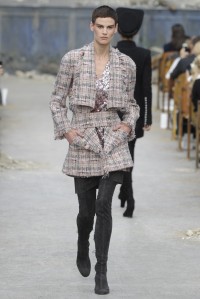1. According to Thomas Schnierer, there are three cardinal attributes that define fashion from a sociological standpoint. “It’s temporal, social, and material aspects (Schnierer, 1995)”. The temporal aspect can be best defined as the way someone goes about being in the moment, knowing that they will have to change quickly and often to maintain their status of being in the moment. Social aspects can be defined as a collective knowledge and general agreement upon a certain look being of the moment. And material can be defined as all of the physical elements that are both bought and/or altered to try and perfect the outward appearance for fashion’s sake.
2. Fashion is play in a sense because we are inherently playful with fashion, because it is such a social interaction with others in society. This interaction is a nonverbal communication and an expression of ones self. “However we may regard it, the very fact that play has a meaning implies a non-materialistic quality in the nature of the thing itself (Huizinga, 1939)”. I think that this is a way of saying that although it isn’t something physical (or for that matter, verbal), it is still present and we see how people send messages through how they look. In a sense, we are also the only animals who are interested in fashion. This, making it a problem strictly for humans. And even if animals are dressed by their owners, they are doing it without any sense of style or fashion, and in turn are just a reflection of their owners own personal message via fashion.
3. The histrionic attitude towards fashion is one of superficial and almost lazy minded as they are dependent upon the opinion and approval of others. This view is widely held and carried out via trends and aspects of superficial fashion such as social norms and how widely these “norms” definitions are accepted by the majority of society. We see these views reported almost constantly. We see them in magazines, on websites, in stores, reiterated through friends, television shows, web videos, and even news sources devote a portion of their reporting to fashion and lifestyle trends. Speaking of lifestyle, it is interesting to learn the origins of this word. “The word lifestyle was first used in the early 1930s by followers of the Austrian psychiatrist Alfred Adler. Adler himself saw lifestyle as a defense mechanism: a pattern of behavior adopted at an early age to disguise physical weakness or inferiorities (Adler, 1912)”. This word is now jus simply defined as a way of life.
The schizoid attitude towards fashion is one that’s based on the belief that you shouldn’t care what others think. If being histrionic seems lazy minded, this is only that to a polar opposite extreme. The book states “In contrast, schizoid personalities (predominately males) do not care about the opinions of others”
(Bonnelli, 228). This view isn’t as lazy minded as it seems. The prime example I can think of is one where someone wants to make a statement by saying they don’t care about what they look like. That they are above it. This view is best explained in a scene in the movie The Devil Wears Prada, where Andrea (Ann Hathaway) laughs at two identical looking belts and is put in her place by Miranda Priestly (Meryl Streep), who is the head of the fashion magazine and decider of which belt shall be shown in an editorial shoot. Because Andrea thinks she is above fashion, or that it is below her because it seems so shallow, she is unaware that she is still choosing colors, clothing, and accessories all still chosen by those very same people making the fashionable decisions.


